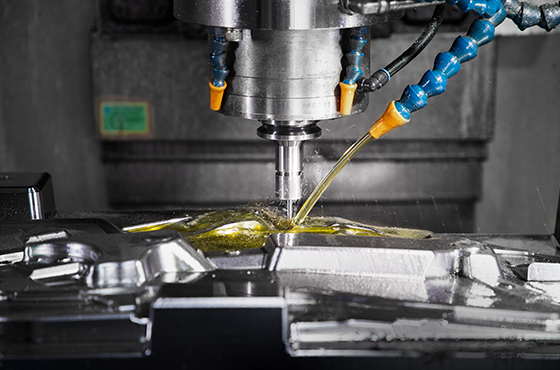You may be ready to start the initial design. There are a lot of little things to consider, though. We aim to ensure you have all the skills you need to design the perfect injection molded part for your customers and team to ensure a smooth delivery.
Choose the right finish for your design
Surface finishes have many additional features besides visual appeal. Before you start picking a finish, you can decide which type of mold you need to use based on the production volume and the material of the mold. Steel molds will be more complex than aluminum molds and offer more surface finish options. The advantage of steel is that it can be polished for a smoother surface finish. This also facilitates painting or other secondary turnkey operations to enhance your product.
Some of the available finishes include
Geometric or patterned shapes
Leather textured to simulate graining
Prepared for painting or auxiliary graphics
Etched with a logo
Sandblasted for a rough, even texture
Glossy, matte, or satin polish
Mirror or lens finishes
Product surface finishes and textures offer a variety of advantages, including making undercuts and hiding parting lines. Strategic textures or finishes in these areas can blend or conceal parting lines. In addition to visual appeal, textures can improve grip, paint adhesion, and allow gases to escape the mold during the injection. The surface treatment should be determined as early as possible so that the mold can make the proper design.
Design parts with consistency in mind
Injection molding is the process of pressing a liquid resin into two halves of a mold. Part thickness limitations can affect the flow rate, which can negatively affect the production line. The best option is to keep the thickness constant, at approximately 2.0 – 3.0 mm. Do not design for wall thicknesses less than 1.0 mm or greater than 4.0 mm, as this can cause additional problems.
Add a drawing to your part
You may have heard about the drafting work related to injection molded parts. Drafting or adding draft angles allows your part to be released from the injection mold. For the release angle, use a minimum of 1° on untextured molds and 3° on textured mold surfaces. These minimum values will allow your part to be released without prying it out of the mold. Your client may require design areas that require close coordination. In this case, try positioning the zero-pull area closer to the mating part rather than the entire surface.
Add radius where possible
The sharp corners on any injection molded part are challenging to form fully. Air can be trapped in sharp corners, so it is best to design them out. The curvature applies to the extraction angle, simplifying the transition and ensuring that your parts can be safely removed from the injection mold.
Always design for resin flow from thick to thin cross-sections
Sometimes it is necessary to design injection molded parts thicker so the structure and strength can be improved. As the molten resin flows through the injection mold, it loses pressure and temperature. As the resin enters the mold, flowing from a thin, tight section to a larger wall thickness will make it challenging to fill the mold away from the gate. The gate should be located in the thicker part of the design, and the resin should flow last to the thinner part.
Select acceptable molding defects
Injection molding can produce defects. Injection molds have two halves that must be joined together, and parting lines may appear at the interface. In thicker parts of the mold, tabs on the back side of the surface design may cause depressions. Ribs in reinforced parts are purposefully designed to add structure. The possibility of visual defects may occur. Still, advanced molding conditions can limit these, and not all of them can be eliminated. You can select surface finishes that reduce the likelihood of becoming a quality issue. You can also move features to locations on the part that will not become a problem if they do leave marks. Select acceptable and unacceptable defects, then design around their limitations.
Reduce the size of the reinforcement rib as much as possible
Reinforcing ribs serve a purpose, but fewer features can create additional problems. Three primary design considerations for each reinforcement rib are bottom thickness, reinforcement height, and total thickness. The bottom of the rib should be designed to be 60% or less of the wall thickness to reduce the chance of surface indentations. The height of the ribs should be as short as possible to reduce the chance of them getting stuck in the injection mold…
The standard for rib height is to make it less than 3 times the thickness of the part. If your part is 1.0 mm thick, the height of the reinforcement should be 3.0 mm or less.
The overall thickness should be less than the thickness of the base, which is directly related to the design of the mold slope. More reinforcing ribs are not always better, so use caution.
Avoid undercuts in the tooling
Undercutting in injection molding tools means that the opening and closing of the tool do not allow the formation of features. In such contexts, lifters and sliders should be used to form features rather than complex shapes. In molding, the simpler, the better. Lifts and sliders can form complex shapes. However, removing the part from the injection mold is still possible.
Manufacturing and error-proof design
Most injection molded parts will be designed to be part of a larger assembly… Of course, some Lego blocks and other small plastic toys do not require any assembly. They are the exception, not the usual rule. When you design parts for assembly, use benchmarks to ensure that the parts are assembled the same way every time. Feature 1 always comes. First, feature 2 comes second, and so on. World-class manufacturing requires designs perfected for manufacturing, and reducing potential errors should be a part of every design.
Use Rapid Prototyping to Identify Early Problems
Rapid prototyping can improve design, manufacturability, and secondary processing. It can also be used to find early design issues that you may still need to identify in your 3D model. The molding industry currently has several options, and your designers should be able to use one of them to create early samples.

